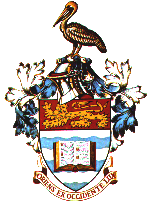![]()
![]()
![]()
![]()
![]()

![]()
![]()
![]()
![]()
![]()
Conjugation mapping is in units of minutes and is a rough mapping process as it can't establish the linkage relationships of close markers. Conjugation mapping is useful for mapping genes that are not close together and up to 1000 kb apart. Transformation is useful for mapping genes 10 to 20 kb apart. A new mutation in E. coli is usually subjected to interrupted mating conjugation experiments and then more precise mapping is performed using other procedures such as transduction.
Transduction is the process in which bacteriophages function as intermediaries in the transfer of genetic information from one bacterium (the donor) to another (the recipient). Such phages (temperate) are called phage vectors. When such a phage infects a bacterial cell and enters the lytic cycle, a small proportion (10-3) of the maturing phage particles may package a small fragment of the host chromosome instead of phage DNA. The amount of DNA packaged is usually less than 1% of the bacterial chromosome. The phage carrying bacterial DNA can adsorb normally onto a sensitive recipient cell and inject the fragment of donor DNA into it.
Once the donor genetic material is in the recipient it may undergo recombination with a homologous region of the chromosome of the recipient. The recipients inheriting donor DNA in this way are called transductants. Two types of transduction occur: in generalised transduction any gene may be transferred between bacteria; in specialised transduction only specific genes are transferred.
Not all phages can perform generalised transduction: T-even phages degrade
host DNA down to nucleotides, while phage l can't because it integrates
at specific sites (as do most temperate phages). Examples of phages that
can perform generalised transduction are P1 of E. coli, and SP01
and PBS1 of Bacillus subtilis. (P1 is of interest also because in
the lysogenic state the 85kb P1 genome does not integrate into the E.
coli chromosome as a prophage, but circularises to form a free plasmid.)
Typically, a transduction experiment is designed so that the donor cell type and the recipient cell type have different genetic markers; then the transduction events can be followed. In generalised transducing phages each transducing particle can package about 1% of the bacterial genome but this 1% of bacterial DNA could come from virtually any region of the bacterial chromosome.
If two markers are transduced together (co-transduced) with high frequency then they are considered closely linked on the bacterial chromosome. Whereas if two markers are never co-transduced, they are probably separated by a length of chromosomal DNA that is at least as long as one phage chromosome or further apart than 1% of the bacterial chromosome.
Bacterial chromosomes can thus be mapped in terms of co-transduction
frequencies. The higher the co-transduction frequency of two markers, the
more closely linked they are. Also it is possible to establish gene orders,
e.g.
if a is co-transduced with b and b is co-transduced
with c, but a is not co-transduced with c, then the
gene order is a-b-c. It is also possible to perform three-factor
transductions and reasoning similar to three factor bacteriophage crosses
can be employed.
Experimentally, the transducing phage is grown on the bacterial donor cells (in liquid medium), the phage lysate is collected and used to infect recipient cells of different genotype. Transductants are selected for one of the donor markers (the selected marker) and these are analysed for the presence of the other unselected markers.
Example
A suspension of P1 was prepared by lytic growth on a trpA+supC+pyrF+ E. coli strain and used to infect a population of trpA- supC-pyrF- recipient cells. Transductants for supC+ were selected and these were tested for their trpA and pyrF genotypes. The following results were obtained by Brenner:
(supC is an ochre suppressor mutation in a tRNATrp gene such that the anticodon recognises UAA and UAG termination codons and inserts tyrosine at the site in the polypeptide.)
supC+ trpA+ pyrF- supC+ trpA- pyrF+ supC+ trpA- pyrF-
As supC+ is the selected marker, the frequencies of co-transduction with supC+ are calculated for trpA+ and pyrF+.
For trpA+, co-transduction frequency is
The distance between the genes can be calculated using the expression
This template created by the Web Diner.